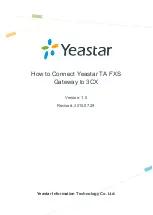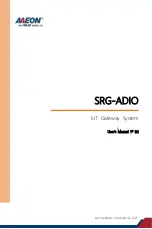
52
About Switch Stacking
24/48-Port 10/100 + 4-Port Gigabit Smart Switch with Resilient Clustering Technology and PoE
Appendix B
the Console port, Telnet or Web-based Utility) and reset
the units to make this assignment permanent.
The unit that is assigned number 1 will act as the Master;
this is indicated by the Stack Master LED on its front panel
being lit amber. The unit that is assigned number 2 will act
as the Backup Master.
Stack Resiliency
A stack’s topology may be either Ring or Chain. The best
practice is to configure the stack in Ring topology, due to
its higher resiliency in case of unit failure or stacking link
failure.
Additionally, if a redundant power supply is used, it is
recommended to make sure that the Master and Backup
Master units are connected to the redundant power
supply.
Advanced Stacking
In order to understand the operation of the stack it is
necessary to understand two key concepts:
Unit IDs, and how they are allocated
Stack unit start up process
Unit IDs
Each unit in a stack has an assigned unique Unit ID number.
Unit ID numbers are meaningful as follows:
The unit that is assigned Unit ID=1 will serve as the
Stack Master
. All other units will be stack members.
The stack Master provides a single point of control,
configuration and management for the entire stack,
and stores the configuration for all stack members
(which themselves do not store any configuration
information at all).
The unit that is assigned Unit ID=2 is a special stack
member, which serves as the
Stack Backup Master
.
A stack Backup Master, in addition to being a stack
member, serves as a Backup in case the stack Master
fails or is disconnected for any reason. If that should
happen, the Backup Master takes over the role of stack
Master for the remaining stack members.
To make this possible, the stack Master will store a copy
of the active configuration on the Backup Master, but
this copy will only be used if and when it takes over the
role of stack Master. Note that only the configuration
file is copied. Any dynamically filled tables, e.g.
addresses learned, are not copied from the Master to
the Backup Master. If the Backup Master takes over
the role of stack Master, it will start building its own
dynamic tables from scratch.
•
•
•
•
Units that are assigned Unit IDs 3-6 (SLM224G4PS)
or Unit IDs 3-4 (SLM248G4PS) are called
Stack
Members
.
A stack member will only operate as a member of
the stack under the direction of an operational stack
Master (or a Backup Master that has taken over the
role).
Stack members are not directly manageable and
configurable, and must be managed through the
stack Master, and do not contain any meaningful
configuration information (not even their own
configuration). If an operational master is not present
and reachable, these units will not be functional.
Master Enabled
units
Units that are assigned a unit ID number of 1 or 2 are
called
master enabled
units. Only master enabled units
participate in master election (see below) whenever
they are initiated, inserted into a new stack or lose
connectivity with the existing master. Only master
enabled units can become the stack master or backup
master. Units with assigned IDs of 3-6 (SLM224G4PS)
or 3-4 (SLM248G4PS) can become neither a master nor
a backup master unless this is done manually by the
system administrator or they are reset to the factory
default first.
Unit ID Allocation
Units are shipped from the factory with no Unit ID, and
must be assigned a unique Unit ID before they can operate
as part of a stack. Unit ID numbers are assigned to units in
one of two ways:
Assigned by the system administrator, in which case
they can only be changed manually by the system
administrator
Allocated to a stack member unit by the stack Master
during system initialization
In general, a unit that was assigned a Unit ID will tend
to keep this number even after it is rebooted. The stack
Master may reallocate Unit IDs during system initialization
to resolve duplicate Unit ID conflicts (see below). Manually
assigned Unit IDs cannot be changed by the stack Master,
even if they are in conflict.
Unit ID assignment/change takes effect only during
system initialization and does not take place during run-
time of the system.
Units of a stack do not have to be numbered in sequence
or in order, and may be interconnected as desired, as long
as each unit has a unique ID and at least one unit of the
stack serves as stack Master.
•
•
•
•
















































